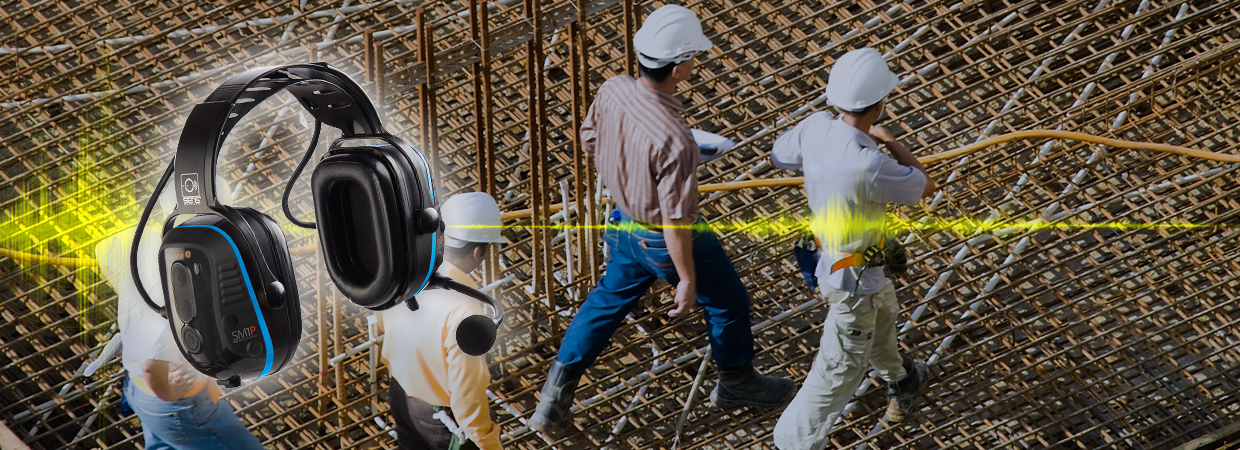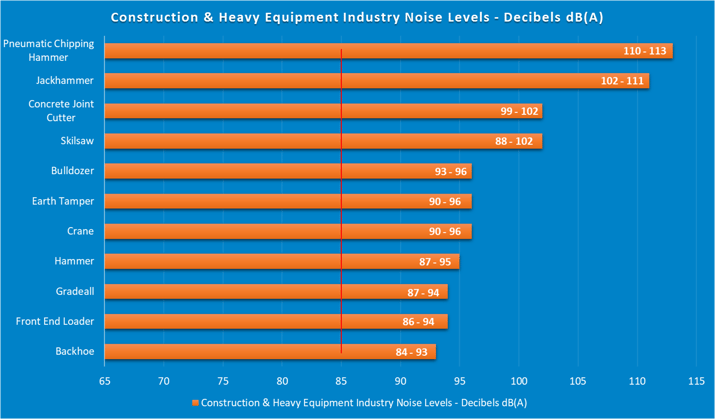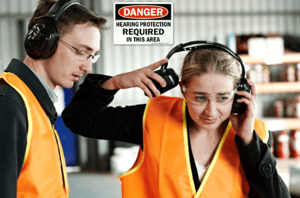- Home
- Blog
- Noise-Induced Hearing Loss
- Top 10 Causes of Hearing Loss in Construction and Heavy Equipment Use

Top 10 Causes of Hearing Loss in Construction and Heavy Equipment Use
According to the National Institute on Deafness and Other Communication Disorders (NIDCD), long or repeated exposure to sounds at or above 85 dB(A) can cause hearing loss. The louder the sound, the shorter the amount of time it takes for noise-induced hearing loss (NIHL) to occur. Based on the study Hearing Loss Among Construction Workers: Updated Analyses, 58% of older construction workers now suffer from significant hearing loss, which was often a result of not taking the appropriate precautions while working in high-noise worksites. A study by Work Care found that employers pay $242 million a year in worker compensation for hearing loss, and these costs were higher in construction than in any other industry.
The Causes of Hearing Loss in the Construction and Heavy Equipment Industry
Workers in the construction industry are surrounded by high-noise levels from heavy equipment. When it comes to noise, there are three main types of noise frequencies: broadband noise, impulse noise, and tonal noise. The below chart shows the average noise level of the 10 most common high-noise-generating power equipment in the various construction industries. Several of the top 10 most common high-noise-generating power equipment in the construction industry can be categorized within one of these three types of noise.
Broadband noise (also called wideband noise) is "noise whose sound energy is distributed over a wide section of the audible range" (Acoustic Glossary: Sound and Vibration Terms and Definitions). Broadband noise can be anything from speech frequencies to loud machinery or large vehicle frequencies, where the noise has random or broad patterns.
Impulse noise is noise characterized by sharp, brief increases in dB volume. Any of the top noise levels in the construction industry land under this type of noise: pneumatic chipping hammer, jackhammer, and hammer. These high-decibel impulse noises can cause temporary or permanent hearing loss, as they are constant and deafening.
Tonal noise (otherwise known as discrete frequency noise) is flat noise that occurs at a single frequency. Tonal noises include blades, fans, motors, or other moving parts that rotate or vibrate. In construction, these noises include the concrete joint cutter, the Skilsaw, and other saws.

Hearing Loss Affects Safety and Communication
Workers with hearing loss can potentially:- Miss alarms, moving vehicles, and other hazards
- Fail to hear emergency broadcasts over two-way radio in
- Experience fatigue, stress, or anxiety from the increased effort to listen
-
Develop tinnitus, causing them to hear ringing, rushing, or other noises
According to the Occupational Safety and Health Administration (OSHA), in all cases where sound levels exceed 85 dB(A) for more than 8 hours, companies are required to implement a hearing conservation program. Hearing conservation programs are designed to prevent occupational hearing loss, preserve remaining hearing, and provide workers with hearing protection to safeguard themselves. These programs can include free hearing exams, hearing protection devices, safety training, and fit-testing evaluations that determine the effectiveness of hearing protection devices.
How Does Sensear Help Improve Safety and Communication Among Construction Workers and Heavy Equipment Operators?
Noise-induced hearing loss (NIHL) is preventable, as are safety and communication problems that arise because of it. Is there a hearing protection and communication solution that solves these problems? In fact, there is - Sensear is a global leader in developing and manufacturing best-in-class Digital Communication Headsets and Earplugs for use in high noise and hazardous environments. Let’s review a few important measures that you can take to improve safety and communication among construction workers and heavy equipment operators.
- Wear hearing protection devices such as earplugs, earmuffs, or headsets, and select the right device for your working environment. Sensear has a whole range of smart protective communication headsets and earplugs.
- Make certain you are wearing a hearing protective device that meets the proper noise reduction rating (NRR, SNR, or SLC80, Class 5) level that meets the requirement for the sound level measured in your work environment. The U.S. Occupational Health and Safety Administration (OSHA) established permissible noise exposure limits for the workplace depending on the noise levels. Calculate the noise level at your ear using our Hearing Protection Calculator to make sure you are meeting these requirements.
- Stay alert for critical noises such as large moving equipment, alarms, forklifts, or other hazards. Our innovative SENS® (Speech Enhancement Noise Suppression) Technology delivers 360° binaural situational awareness, ensuring that you have a complete awareness of what is happening around you at all times.
 Don’t remove your earmuffs or pull out your earplugs to talk to one another on the job site with the risk of damaging your hearing. SENS® Technology brings low-noise hearing experiences into high-noise environments by enabling users to communicate effectively and remain aware of their surrounding while protecting their hearing.
Don’t remove your earmuffs or pull out your earplugs to talk to one another on the job site with the risk of damaging your hearing. SENS® Technology brings low-noise hearing experiences into high-noise environments by enabling users to communicate effectively and remain aware of their surrounding while protecting their hearing.- Ensure you can communicate face-to-face, at short and long distances via two-way radio, Bluetooth® cell phone, and other communication systems, especially during emergency broadcast communications. Sensear's headsets and smartPlugs™ prioritize two-way communication over all other frequencies, even with the volume limiter on. This allows you to always be alerted to emergency broadcasts over your two-way radio channels.
Sensear’s Noise-Canceling Hearing Protection Solutions for Construction Workers and Heavy Equipment Operators
Industrial Noise Cancelling Two-Way Radio Headsets
These Industrial headsets offer a rugged design that holds up well in these tough environments as well as a noise-canceling boom mic for clear two-way radio communication via cable connection and Sensear’s patented SENS® Technology.
- Two-way radio communication
- Face-to-face communication via SENS® Technology
- 360° situational awareness via SENS® Technology
- Simultaneous audio
- NRR up to 27dB
Industrial Noise-Canceling Two-Way Radio Headsets with Bluetooth®
These rugged headsets offer a noise-canceling boom mic, a two-way radio cable connection, Bluetooth® for wireless connection to a Bluetooth® wireless technology enabled communication device (cell phone, tablet, or two-way radio), and Sensear’s patented SENS® Technology.
- Two-way radio communication via cable connection and/or Bluetooth® connection to a two-way radio
- Cellular communication via Bluetooth® connection to a cellular device
- Internal short-range radio for headset-to-headset communication
- Face-to-face communication via SENS® Technology
- 360° situational awareness via SENS® Technology
- Simultaneous audio
- 82 dB(A) in-ear volume limiter
- Noise reduction rating up to 31dB NRR
Industrial Noise-Canceling Two-Way Radio Earplugs and Industrial Noise-Canceling Bluetooth® Wireless Technology Earplugs
Sensear's smartPlug™ Series offer an in-ear microphone along with a variety of features similar to our headsets, a two-way radio cable connection, Bluetooth® for wireless connection (cell phone, tablet, or two-way radio), and Sensear’s patented SENS® Technology. In addition to the smartPlug™, Sensear also offers the all-new SP1R, which has the option of earplugs with an in-ear microphone, or a lightweight, heavy-duty headset with earplugs and an external noise-canceling boom microphone. The SP1R's in-ear microphone is specifically for users of respirators or other equipment that restricts boom mic usage. With the boom mic's crystal clear audio of up to 120 dB(A), these two earpiece models make the SP1R the ideal earplug solution for use with or without full-face protection devices or protective suits.
smartPlug™:
- Two-way radio communication via cable connection and/or Bluetooth® connection to a two-way radio
- Cellular communication via Bluetooth® connection to a cellular device
- Internal short-range radio for headset-to-headset communication
- Face-to-face communication
- SENS® Technology (360° situational awareness)
- Simultaneous audio
- 82 dB(A) in-ear volume limiter
- Noise reduction rating up to 31dB NRR
SP1R:
- Small compact design built into a larger ergonomic push-to-talk button
- Detachable earpiece assembly with two options (earplugs with an in-ear mic or a lightweight headset with earplugs and a noise-canceling boom mic.)
- SENS® Technology (face-to-face communication and 360° situational awareness)
- Disposable foam ear tip for user comfort
- 82 dB(A) in-ear volume limiter
- Clear two-way radio communication in high-noise environments
- Connects to most industry-leading two-way radios via a wired connection
- No battery, the unit is powered by the radio
- The in-ear mic option is ideal for use with respirators and breathing protection devices
- Noise reduction rating up to 31dB NRR
- Intrinsically safe (IS) with UL and CSA certifications
With Sensear’s wide range of products, we have a solution for your unique requirement. Schedule a call with one of our hearing protection specialists and let’s talk, so we can help you determine the best hearing protection solution for your hearing conservation and safety program designed around the construction and heavy equipment industry.






